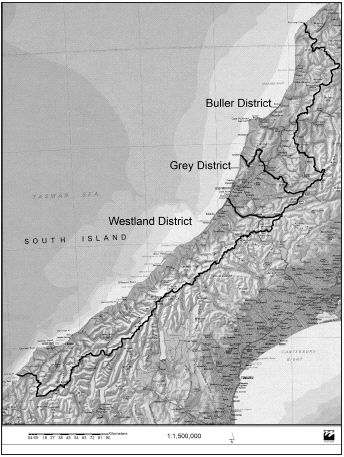Part 1: Introduction
The West Coast Economic Development Funding Package
1.1
In May 2000, Cabinet agreed to make a once-only payment of $120 million (GST-exclusive) to help the South Island’s West Coast economy adjust to the Government’s policies to end the logging of indigenous forest.
1.2
The $120 million payment was split between the 4 West Coast local authorities (Buller District Council, Grey District Council, Westland District Council, and West Coast Regional Council) and an entity about to be formed – the West Coast Development Trust (the Trust).
1.3
Each local authority received $7 million to use as it saw fit.
1.4
The remaining $92 million was given to the Trust, which was established by the Crown, after regional consultation. The conditions attached to the $92 million payment were set out in the Deed of Trust (the Deed), which was negotiated by the Settlor (the Minister of Finance) and a committee of West Coast mayors, local authority chief executives, and the West Coast Regional Council’s chairperson.
1.5
The Deed states that the Trust is a charitable trust to benefit the present and future inhabitants of the West Coast region. According to the Deed –
… the Trust Fund may be applied and used exclusively by the Trustees for the following general purposes within New Zealand (the Objects), namely:
(a) to promote sustainable employment opportunities in the West Coast region; and
(b) to generate sustainable economic benefits for the West Coast region; and
(c) to support projects which are not the ordinary day-to-day running, maintenance and upgrade of the infrastructure that is normally the responsibility of the local authorities or central government, provided such projects meet paragraphs (a) and (b)…
The West Coast region
1.6
The West Coast region covers more than 23,000 square kilometres, or 8.5% of New Zealand’s land area. The distance from the top to the bottom of the West Coast region is roughly the same as the distance between Auckland and Wellington.
1.7
The region’s population of slightly more than 30,000 is spread throughout some 60 towns and settlements. The region is made up of distinct communities that have traditionally tended to act in a strongly independent manner.
1.8
The 3 districts which make up the region are:
- Buller district, which lies to the north of the region and has a population of about 10,000. Its main centre is Westport. The district has plentiful coal, gold, and limestone reserves, and boasts high agricultural production.
- Grey district, which sits in the middle of the region and has a population of about 13,000. Its main centre, Greymouth, is the largest town in the region.
- Westland district, which covers the southern part of the region and has a population of about 8,000. Its main town is Hokitika. The Franz Josef and Fox Glaciers provide for a strong tourism industry.
1.9
Figure 1 shows the 3 districts, and their location on the West Coast of the South Island.
1.10
In 2000, when the West Coast region received the funding package from the Government, its Gross Domestic Product was below the national average. Results of the 2001 Census found the median income of people in the West Coast region was $14,600, compared with $18,500 for all of New Zealand. The unemployment rate in the West Coast region was 6.7%, compared with 7.5% for all of New Zealand.
1.11
By June 2004, a regional growth rate of 5.6% had been achieved – the highest in the country, and well ahead of the national average of 4.3%. The unemployment rate had dropped to 3%, when the national rate was 4%. These changes can be attributed to a growth in the mining, agriculture, and tourism industries.
Why we conducted an audit
1.12
The provision of $120 million to the West Coast region was a significant investment by the Government. Five years later, we thought it timely to conduct an audit to provide assurance to Parliament that the funding package was being managed appropriately, and that it is being used as Parliament intended.
1.13
We did not choose to do this audit because of publicity about the failure of particular initiatives undertaken by 2 district councils, using their share of the funding package. Rather, the aim of the audit was to take a regional view of the custodianship and use of the funding package.
1.14
The Trustees and the Settlor must review the operation of the Trust before 30 June 2006. The findings of our audit will inform that review.
Figure 1
The West Coast region

Purpose of the audit
1.15
The purpose of the audit was to:
- check that appropriate systems and processes were in place for managing the funding allocated to the West Coast local authorities and the Trust; and
- test that the operation of the Trust, and the distribution of funds by the Trust, have complied with the Deed.
How we conducted our audit
1.16
To carry out our audit, we:
- accounted for how the funding package had been invested and used by each of the 4 local authorities and the Trust;
- reviewed the files for all the business investments made by the Trust, and the files for all community funding and regional development projects for amounts greater than $50,000; and
- reviewed documents relating to investments and fund management by the local authorities and the Trust.
1.17
We also interviewed:
- past and current Trustees;
- Advisory Body members;
- the Trust’s Chief Executive and staff;
- the 3 Mayors;
- the West Coast Regional Council’s Chairperson and Deputy Chairperson; and
- local authority Chief Executives and staff.

